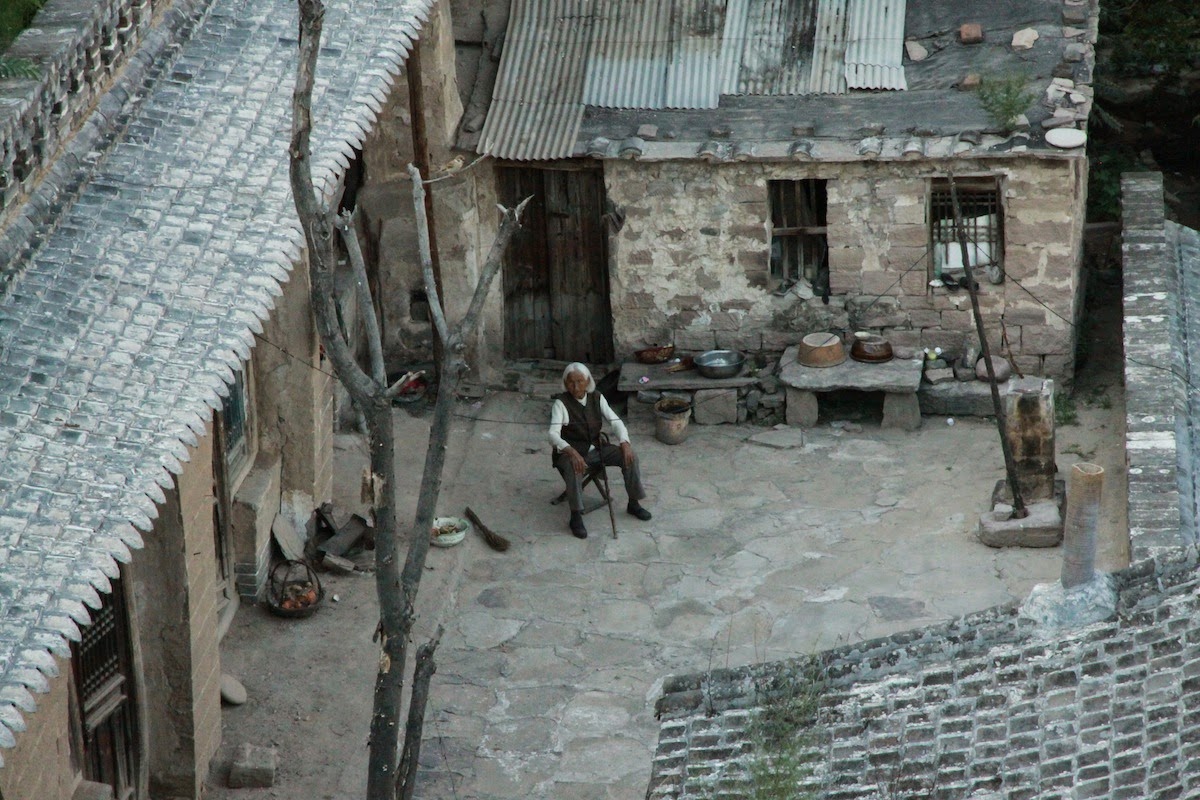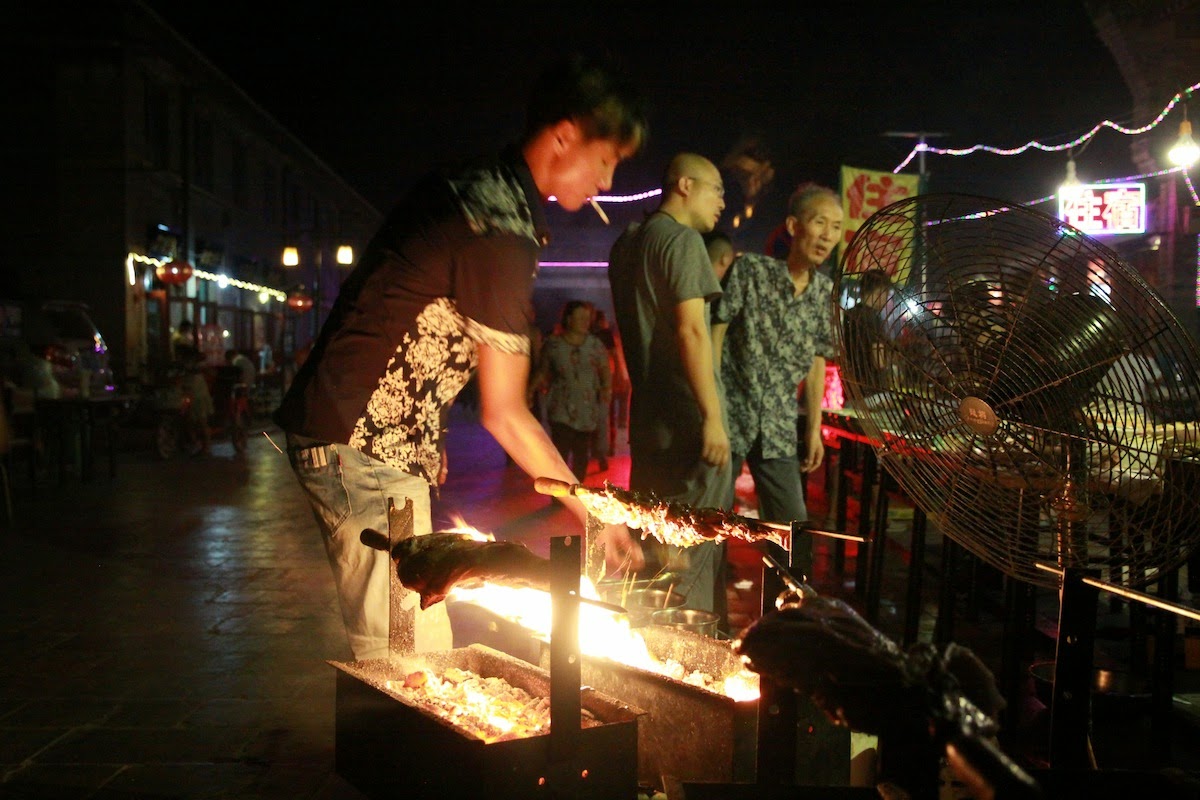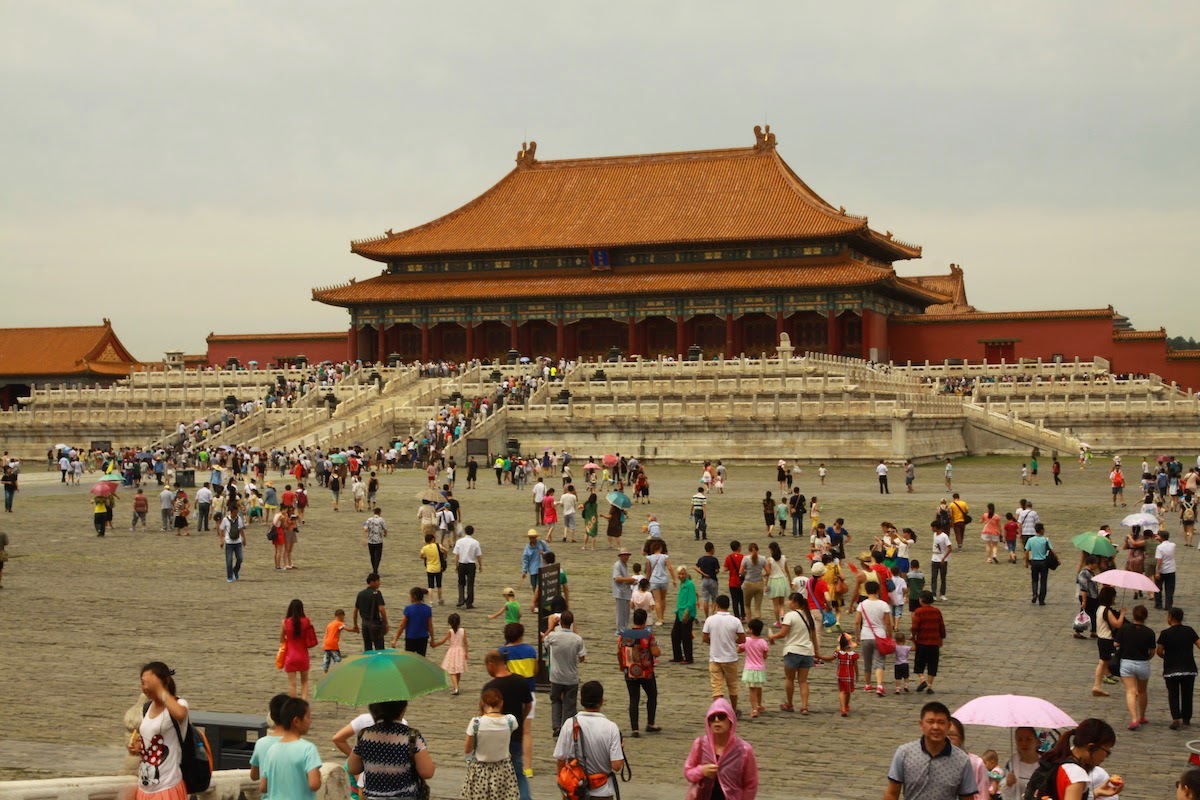In which we got a lesson on communism, spent the night in a cave, got badly bruised,
clung on to the side of a cliff, met giant Buddhas, scaled great walls high on the
mountains, crossed in to ‘Mongolia’ and reached our final destination in one piece!
From a terracotta army to a red one, we left Xi’an and headed to Yan’an. It was home to the CCP, The Chinese Communist Party, after they made a very hasty and rather elongated retreat from the East over 6400km to escape their enemies during the 1930s when they were vying for power, this is now referred to as The Long March and it led them to a backwater town in the hills where they could safely hide and build their plan for a Communist China. Yan’an became something of a guinea pig, a model communist town with communal living, co-operative farms, self-sufficiency and a military-style rule, all of which would spread to the rest of the country when China officially became communist in 1949.
It is home to a very large, flash museum which celebrates the communist history of the town and country and we all visited, some of us were a bit bemused by most of it, the English translations weren’t much help, there was a lot of political doublespeak and references to historical events we never learned about in the West. But with a bit of reading between the lines and an open mind it gave us a very interesting view in to Chinese politics and how the CCP views themselves and their role in modern China.
China is a country full of contradictions and contrasts and our next stop couldn’t have been
more different. China is developing, fast, our journeys on its brand spanking new roads are
met with views like this
Row after row of new identical tower blocks where countless millions of people live, often here it feels like the past is being packaged up in to little pockets of tourist attractions to be visited, enjoyed and then forgotten as the country surges forward to be a modern superpower. So frankly it is a miracle that somewhere like our next destination still existed.
Lijiashan is tiny, its streets are so small that most cars can’t get in, let alone our lovely
truck Penelope who we left down by the main road. It is a village of cave houses,
traditional to this part of the country, the homes are dug in to the ground and then beautiful
wooden facades built on the front. The rooms are cool, quiet and comfortable, outside
there is no traffic noise, no beeping, no shouting, only the occasional cockerel. We
stepped around a corner to what felt like a different century or a film set.
We settled in for the night to our giant communal rooms with huge beds and enjoyed a little slice of village life, a little moment of calm in a vast modern country. It was a very special and unexpected place. The local people were kind and fascinated with us, especially our arms which they said were very hairy! At night they all vanished off in to the woods with UV lights and then reappeared with plastic bottles full of scorpions that they had been hunting!
From a terracotta army to a red one, we left Xi’an and headed to Yan’an. It was home to the CCP, The Chinese Communist Party, after they made a very hasty and rather elongated retreat from the East over 6400km to escape their enemies during the 1930s when they were vying for power, this is now referred to as The Long March and it led them to a backwater town in the hills where they could safely hide and build their plan for a Communist China. Yan’an became something of a guinea pig, a model communist town with communal living, co-operative farms, self-sufficiency and a military-style rule, all of which would spread to the rest of the country when China officially became communist in 1949.
It is home to a very large, flash museum which celebrates the communist history of the town and country and we all visited, some of us were a bit bemused by most of it, the English translations weren’t much help, there was a lot of political doublespeak and references to historical events we never learned about in the West. But with a bit of reading between the lines and an open mind it gave us a very interesting view in to Chinese politics and how the CCP views themselves and their role in modern China.
 |
| Chairman Mao |
 |
| At the Museum |
 |
| Museum signage |
 |
| Communist gift shop - a Mao for all seasons |
 |
| Mixed reviews of the museum from local visitors |
 |
| Funny sign at our hotel - "Chinglish" translations are a source of great amusement for many of us |
 |
| Evening in Yan'an |
Row after row of new identical tower blocks where countless millions of people live, often here it feels like the past is being packaged up in to little pockets of tourist attractions to be visited, enjoyed and then forgotten as the country surges forward to be a modern superpower. So frankly it is a miracle that somewhere like our next destination still existed.
 |
| Lijiashan, the cave village |
We settled in for the night to our giant communal rooms with huge beds and enjoyed a little slice of village life, a little moment of calm in a vast modern country. It was a very special and unexpected place. The local people were kind and fascinated with us, especially our arms which they said were very hairy! At night they all vanished off in to the woods with UV lights and then reappeared with plastic bottles full of scorpions that they had been hunting!
 |
| The layers of cave houses meant we could see into all the small yards, and catch glimpses of the life these villagers are clinging on to |
 |
| The houses dug into the cliff sides |
 |
| Relaxing in the courtyard |
 |
| Entrance |
 |
| Comes complete with a kitten and a puppy with pink ears, who could ask for more? |
 |
| Ross and Gary make themselves at home |
The next morning we visited a local temple full of beautiful carvings and statues and even
a resident camel!
Our next stop was the ancient city of Pingyao, famous for being the most in tact walled city in China, it is an impressive sight and looked very much like we’d all imagined China to look before we arrived. There are red lanterns everywhere, wooden pagodas all over the place, mahjong being played on the streets, it is a feast for the eyes and a really beautiful place.
It does have rather a lot of tourists visiting and lots of souvenir shops, we saw many
European-looking faces for the first time in a while, but it was easy to step outside the
chaos of the main streets and find little back alleyways with enticing looking doorways
leading to beautiful courtyards and ramshackle buildings.
Just outside the walls modern China comes pouring back with a buzzing night market, an
army of silent electric scooters everywhere you turn and bright neon lights.
A highlight for a few of us had to be getting massages where some of us made the mistake
to saying yes to a ‘scraping’ where our backs were attacked with sharp bits of plastic used
to scrape all the aches and pains away (we assume, it’s often hard to understand what’s
going on here!) which felt fantastic but left our backs covered with bruises that looked like
tiger-striped love bites! (No photos sadly!)
Our next stop was the city of Datong which we used as a base to visit some local ancient sights. Firstly we visiting the inconceivably precarious ‘Hanging Monastery’ which is, well, exactly what it sounds like!
It’s a very impressive structure and anyone with vertigo is best to stay at the base as it is a little treacherous to get around, particularly with the stream of tourists flowing through it. It has staircases that feel more like ladders and there was a lot of clinging to walls and poles as we went around. There were some beautiful old carvings and rooms left with their original fittings to enjoy, the monks left here some time ago, presumably to a place on a nice firm bit of flat ground, but probably nowhere near as photogenic as this one!
We also headed over to The Yungang Grottoes, similar to the Mogao and Bingling Si
Caves we had visited before this was in some people’s opinion the crowning glory, built in
the 5th century and influenced by far flung places such as India, Persia and even Greece
as visitors travelled along the Silk Road they are pretty spectacular with Giant Buddha
statues all over the place, ancient carvings, wall paintings and rooms where it wouldn’t be
out of place if Indiana Jones suddenly ran through being chased by a boulder. It also makes for fantastic photo opportunities and being more out in the open than many of the
other grottoes we were able to exercise our itching camera fingers and get some great
pictures with no risk of damaging the statues with flashes.
 |
| And we thought we had left the Silk Road behind! |
 |
| Local donkey |
 |
| The temple |
 |
| Dave lights a candle |
 |
| Dragon carvings |
Our next stop was the ancient city of Pingyao, famous for being the most in tact walled city in China, it is an impressive sight and looked very much like we’d all imagined China to look before we arrived. There are red lanterns everywhere, wooden pagodas all over the place, mahjong being played on the streets, it is a feast for the eyes and a really beautiful place.
 |
| Pingyao's picture perfect walls |
 |
| Tourists flock to the shopping streets |
 |
| This little kid was enjoying some heavy metal music blasting out of a western bar |
 |
| Men play a local game in the middle of the busy streets |
 |
| Shoulders of lamb cooked out in the open |
 |
| A soy sauce fountain, one of many weird and wonderful tourist souvenirs |
 |
| Quiet back streets |
 |
| Roof tiles |
 |
| Beautiful courtyards |
 |
| Whilst within the walls it is mostly car free, outside the walls we were back to modern China |
 |
| An army of electric scooters |
 |
| We headed to a hot pot restaurant where you get to pick and cook your own food off the conveyor belt |
Our next stop was the city of Datong which we used as a base to visit some local ancient sights. Firstly we visiting the inconceivably precarious ‘Hanging Monastery’ which is, well, exactly what it sounds like!
It’s a very impressive structure and anyone with vertigo is best to stay at the base as it is a little treacherous to get around, particularly with the stream of tourists flowing through it. It has staircases that feel more like ladders and there was a lot of clinging to walls and poles as we went around. There were some beautiful old carvings and rooms left with their original fittings to enjoy, the monks left here some time ago, presumably to a place on a nice firm bit of flat ground, but probably nowhere near as photogenic as this one!
 |
| Anita, Dave and Sue pick their way along |
 |
| Roof carvings |
 |
| Iain makes his way carefully down the stairs |
 |
| Traditional Kang bed at the monastery with space for a fire underneath for the cold winter months |
 |
| Monastery carvings |
 |
| Yungang |
 |
| There must be something exciting in that cave... |
 |
| Yes there is! |
 |
| Simon and Buddha |
That evening we found a fantastic restaurant which brought half-cooked shoulders of lamb to our tables with hot coals and we sliced bits off as it cooked in front of us. Very tasty! Chinese food has been consistently excellent.
 |
| Lamb time! |
 |
| Jo-Ann carves |
 |
| Mmmm |
 |
| Now that really is a great wall! |
We almost had the place to ourselves and as dusk set in we grabbed a beer or a sneaky vodka left over from Kyrgyzstan to toast the wall, the journey we had nearly completed and the country that had built this amazing structure.
We exited the wall at one of the ancient border crossings between China and Mongolia, and whilst the border is considerably further North these days we are all adding Mongolia to our list of countries we have ‘sort of’ visited on this trip.
The next day brought our final drive in Penelope and it was a sad goodbye to our trusty steed as we unloaded everything at the hotel in Beijing. But the bright lights of bustling Beijing awaited us! There are possibly 9 million bicycles here, but there are also about 90 million electric scooters, almost completely silent until they are about an inch away from you where they beep loudly until you leap out the way.
Beijing also has a lot of people, A LOT of people, which we discovered when we visited Tiananmen Square and The Forbidden City, a large palace complex of ancient buildings, it is very impressive for its architecture and also a brilliant place to people watch, it receives 30,000 visitors a day, that’s over 10,000,000 a year, the majority are Chinese tourists but you do often spot a slightly bemused looking European face, crowds of this size just don’t exist outside China! It’s an experience, a very Chinese one, and gave us a sense of exactly what a population of 1.4 billion really means!
 |
| Outside the Forbidden City - Chairman Mao's face still watches over Tianenmen Square |
 |
| Joining the crowds to get into the City |
 |
| The Forbidden City is a huge citadel of courtyards and passages steeped in history and folklore |
 |
| Emma finds a bit of space for messing around in the mayhem |
 |
| It boasts some excellently preserved architecture |
 |
| Local tourists hire traditional costumes for the perfect photo |
 |
| Families and couples on holiday often dress alike in China |
We marked our final evening together with some Peking Duck appropriately, being the old
name for Beijing, and gathered for a group meal and to celebrate Simon’s birthday.
It was an evening spent reminiscing, discussing our favourite moments, retelling funny
stories and remembering the wonderful people we’d met along the way. For many of the
group it has been a pilgrimage of sorts, to travel in the steps of Marco Polo, Timur and
Genghis Khan has been a lifelong dream and the silk road of today, whilst very different,
has thrown up as many adventures for us in the 21st century as it would have back then.
For others it has been their first experience travelling in strange exotic places and many
have caught a very bad case of the overland travel bug! From a group of slightly nervous
strangers in Istanbul we ended a group of friends who have shared an adventure we’ll
never forget.
 |
| Jackie lights Simon's brilliant Chinese birthday candle |
 |
| It exploded, spun and played music! |
 |
| Happy birthday Simon! |
 |
| Istanbul to Beijing 2014 |















